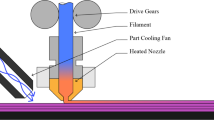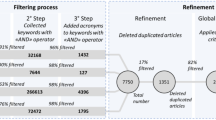Abstract
A rapid prototyping and high-precision technology for manufacturing a linear motion (LM) guideway is proposed in this paper. In this technology, a trough is laid on the die, and a ram is used to press the billet before extrusion to produce high hydrostatic stress on the cutting edge of the die. The punch diameter is designed to be larger than the die hole but smaller than the die diameter. Hence, the action of the punch traveling downward to extrude the billet can increase the hydrostatic pressure around the cutting edge of the punch and die, thereby eliminating product fracture. LM rails of linear guides were formed using an experimental test, in which all the product processes were completed in only a few minutes. The results indicated that this approach can extrude a part of the linear guide with an excellent burnished surface. The test range for the roughness of the burnished surface was R a = 0.03–0.21 μm, and the tolerance band for the width and thickness ranged from IT1 to IT4. This novel approach provides a more rapid prototyping technology as well as precise sizes higher than those obtained using traditional manufacturing methods.
Similar content being viewed by others
References
Wang JP, Huang GM (2016) Fine extrusion device approach. Int J Adv Manuf Technol 86:1733–1737
Huang GM, Wang JP, Chen TT, Chen CL, Xu MH (2015) Optimal design for the fluid cavity shape in hydromechanical fine blanking. Int J Adv Manuf Technol 78:153–161
Wang JP (2015) A novel fine-blanking approach. Int J Adv Manuf Technol 78:1015–1019
Mielnik EM (1993) Metalworking science and engineering. McGraw-Hill, Inc., New York
Aida T, Takatsuji N, Matsuki K, Ohara T, Kamado S (2006) Effects of extrusion speed on properties of the extruded AZ31B magnesium alloy machined chip. Journal of Japan Institute of Light Metal 56:166–171
Huang YM, Chen JM (2013) Surface permeation and die design during rod extrusion process. Int J Adv Manuf Technol 69:397–403
Furukawa M, Iwahashi Y, Horita Z, Nemoto M, Langdon TG (1998) The shearing characteristics associated with equal-channel angular pressing, Mater Sci Eng A257 328–332
Chen YC, Huang YY, Chang CP, Kao PW (2003) The effect of extrusion temperature on the development of deformation microstructures in 5052 aluminium alloy processed by equal channel angular extrusion. Acta Mater 51:2005–2015
Bowen JR, Gholinia A, Roberts SM, Prangnell PB (2000) Materials Science and Engineering A287 87–99.
Avitzur B (1980) Metal working the application of limit analysis. Marcel dekker, New York
Author information
Authors and Affiliations
Corresponding author
Rights and permissions
About this article
Cite this article
Chen, CL., Wang, JP., Huang, GM. et al. High-precision rapid prototyping technology for manufacturing linear guides. Int J Adv Manuf Technol 92, 3137–3142 (2017). https://doi.org/10.1007/s00170-017-0378-y
Received:
Accepted:
Published:
Issue Date:
DOI: https://doi.org/10.1007/s00170-017-0378-y




